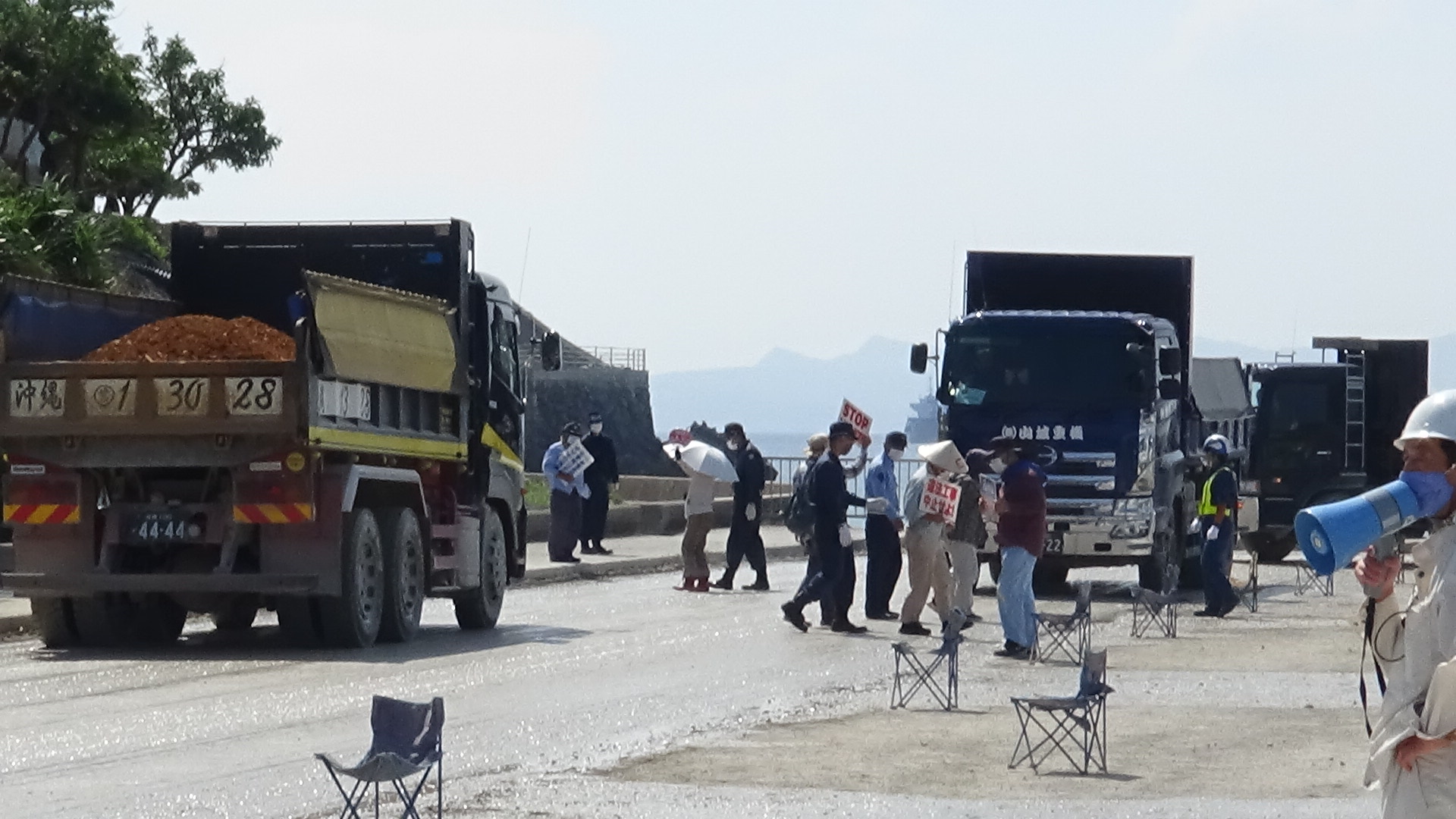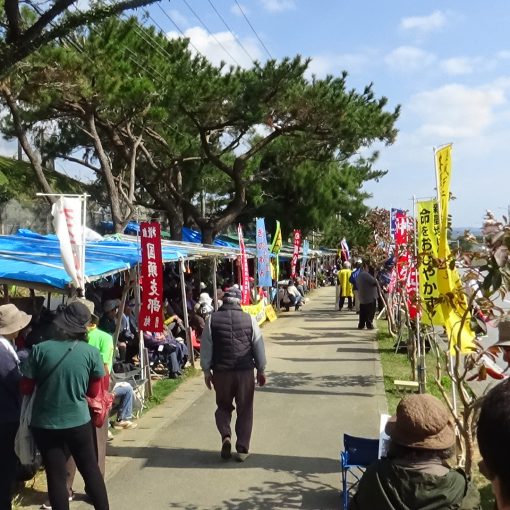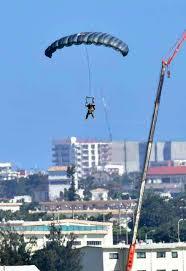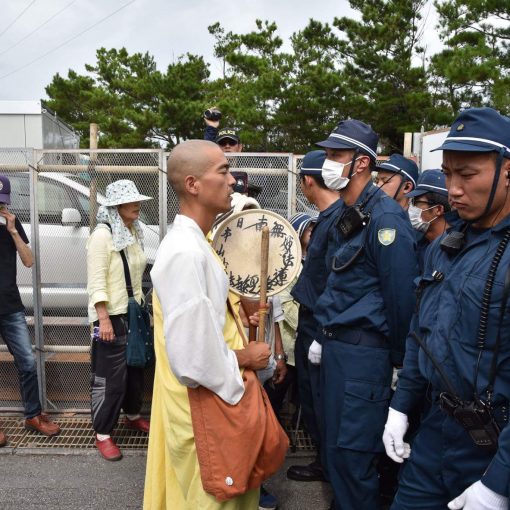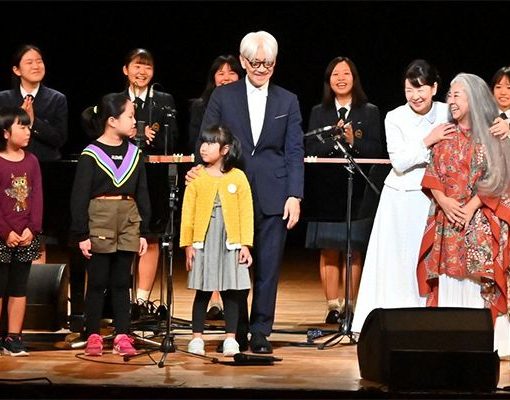“The sea is the heart of Okinawa. We should never destroy it unnecessarily. We will never allow its destruction for the sake of war!” Mr. Zenji Niina (67) emphatically repeated. He is from Tima, a village located on the opposite side of Camp Shwab. If the new base is built, US military aircraft take off from the base roaring over Tima.
“In January 2019, when the landfill work began, he founded a Nago-shi Higashi-Kaigan Iriai Gyogyou-Kumiai (Nago East Coast Local Fishery Association). It is a provisional organization until recognized as a formal fishery union. The Nago Fishery Union sold the Oura Bay’s fishing rights to the Okinawa Defence Bureau, leaving no commercial fishing in the Oura Bay. The neighboring communities on the east coast of Nago City decided to make the Oura Bay as their fishing ground for livelihood and obtain commercial fishing rights. Thirty residents of Nago East Coast, such as ex-fishermen, fisher-farmers, homemakers, and self-employed workers, joined.
Mr. Susumu Inamine, the former mayor of Nago City, and Mr. Kazuki Kumamoto, honorary professor of Meiji Gakuin University and a leading expert in the Fisheries Law, were among the members of the advisory board.
The Local Fishery Association, not engaged in pelagic fisheries, is limited to Ino (shallow-water) fisheries. The members work hard to prove that it is a productive organization. They own three fishing boats so that Association members can go fishing at any time. They also started selling Ikara (a processed marine product that is a mixture of squid and miso) to cover the Association’s running cost. The orders for Ikara are flooding from supporters all over Japan, and the Association’s leader himself is busy with production.
When they obtain the new fishing right in Oura-Bay, he is confident it will serve as a power center to fight against the new base. “I want to protect the sea as we have inherited from our ancestors so that we can hand it over to the next generation.” Niina’s vision for the Association is clear.

(In front of Camp Shwab Gate)
Twenty-seven senior-highschool students of Wako Gakuen in Tokyo visited the Camp Shwab Gate’s tent. The visit is a part of the fieldwork of an elective class on military base issues, and it has been continuing since 1996. In the Gate’s tents, 91-year-old Fumiko Shimabukuro shared her tragic war experience. Fumiko said, “Japanese military did not fight to protect the Japanese people. We cannot let anyone die in the war anymore.” The students eagerly nodded and took notes. One of them said, “I now understand well that the war experience and protest against the military bases are inseparable.”
On that day, 149 dump trucks including concrete mixers entered the gate.


(Ryukyu Cement Awa Pier)
After two days without any shipping out, they started loading earth and sand around noon. The protesters gathered in Motobu Shiokawa Pier quickly moved to Awa Pier, and so did the riot police. In front of the Awa Pier exit gate, fierce exchanges took place between the protesting citizens and the riot police who try to control the protesting citizens. Members of GoGo Drive also participated with six cars. The police commander, frustrated that the dumps could not move out the exit gate, threatened the protesters using a hand-microphone. At one point, he brought the hand-microphone close to the face of one of the protesters and yelled loud.
A total of 753 dumps carried the earth and sand to load into three ships, which left for the Oura-bay.


(Motobu Shiokawa Pier)
Since no work in progress at Awa Pier in the morning, about 40 citizens gathered at Shiokawa Pier. Protesting citizens walked around in the Port and caused the delay to the entering dumps. The riot police arrived in two armored vehicles, and 40 riot police members controlled the protests. The earth and sand of 511 truckloads were loaded into four sand carriers with a grub bucket.


Number of dump trucks to date and percentage against the total
The estimation calculated on the basis of the number of ruckloads serves only as a reference.
Number of dump trucks which made delivery from December 2018 to the end of December 2019 114,601(1.39%)
| 10(Sat) | 12(Mon) | 13(Tue) | 14(Wed) | 15 (Thr) | 16(Fri) | |
| Awa | 840 | 0 | 0 | 753 | ||
| Shiokawa | 0 | 619 | 513 | 511 |
| Number of dump trucks ※ |
Weightt of earth/sand
※① |
Converted to volume
※② |
Volume per Total
※③ |
| 260,128 | 1,300,640t | 650,320㎥ | 3.219% |

